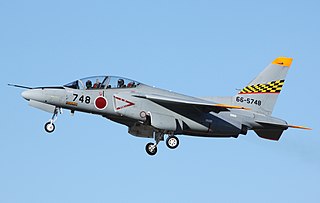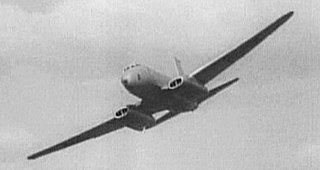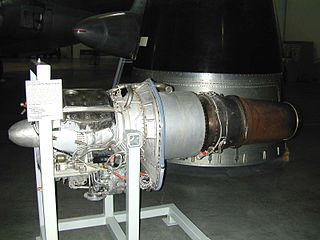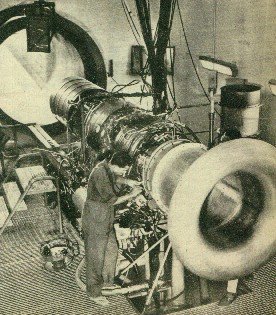
The BMW 003 is an early axial turbojet engine produced by BMW AG in Germany during World War II. The 003 and the Junkers Jumo 004 were the only German turbojet engines to reach production during World War II.

The Nakajima Kikka, initially designated Kōkoku Nigō Heiki, is Japan's first turbojet-powered aircraft. It was developed late in World War II, and the single completed prototype flew only once, in August 1945, before the end of the conflict.

The Ishikawajima Ne-20 was Japan's first turbojet engine. It was developed during World War II in parallel with the nation's first military jet, the Nakajima Kikka.

The Mitsubishi T-2 was a supersonic jet trainer aircraft used by the Japan Air Self-Defense Force. Introduced in 1975, it was the first Japanese-designed aircraft to break the sound barrier. It was the basis of the Mitsubishi F-1 strike fighter. All T-2s were retired by 2006.

The British Aerospace 125 is a twinjet mid-size business jet. Originally developed by de Havilland and initially designated as the DH.125 Jet Dragon, it entered production as the Hawker Siddeley HS.125, which was the designation used until 1977. Later on, more recent variants of the type were marketed as the Hawker 800.

The HAL HF-24 Marut was an Indian jet fighter aircraft developed and manufactured by Hindustan Aeronautics Limited (HAL) during the 1960s and early 70s. The Marut was designed by the German aeronautical engineer Kurt Tank, with the Project Engineer being George William Benjamin. The aircraft was the first Indian-developed jet fighter. On 17 June 1961, the type conducted its maiden flight; on 1 April 1967, the first production Marut was officially delivered to the IAF.

The Kawasaki T-4 is a Japanese subsonic intermediate jet trainer aircraft developed and manufactured by the commercial conglomerate Kawasaki Heavy Industries. Its sole operator is the Japan Air Self-Defense Force (JASDF), in part due to historic restrictions on the exporting of military hardware. In addition to its primary training mission, the T-4 has been used by the JASDF's Blue Impulse aerobatic team as well as liaison duties with most fighter units. The first XT-4 prototype flew on 29 July 1985, while the first production aircraft was delivered during September 1988.

The Armstrong Siddeley Sapphire is a British turbojet engine that was produced by Armstrong Siddeley in the 1950s. It was the ultimate development of work that had started as the Metrovick F.2 in 1940, evolving into an advanced axial flow design with an annular combustion chamber that developed over 11,000 lbf (49 kN). It powered early versions of the Hawker Hunter and Handley Page Victor, and every Gloster Javelin. Production was also started under licence in the United States by Wright Aeronautical as the J65, powering a number of US designs. The Sapphire's primary competitor was the Rolls-Royce Avon.

The HAL HJT-16 Kiran is an Indian two-seat intermediate jet-powered trainer aircraft designed and manufactured by aircraft company Hindustan Aeronautics Limited (HAL).

The Armstrong Siddeley Viper is a British turbojet engine developed and produced by Armstrong Siddeley and then by its successor companies Bristol Siddeley and Rolls-Royce Limited. It entered service in 1953 and remained in use with the Royal Air Force, powering its Dominie T1 navigation training aircraft until January 2011.

The Bristol Siddeley Orpheus is a single-spool turbojet developed by Bristol Siddeley for various light fighter/trainer applications such as the Folland Gnat and the Fiat G.91. Later, the Orpheus formed the core of the first Bristol Pegasus vectored thrust turbofan used in the Harrier family.

The Avro 706 Ashton was a British prototype jet airliner made by Avro during the 1950s. Although it flew nearly a year after the de Havilland Comet, it represented an experimental programme and was never intended for commercial use.

The Pratt & Whitney JT12 is a small turbojet engine. The Pratt & Whitney T73 is a related turboshaft engine.

The Bréguet Br.1001 Taon was a 1950s French prototype single-seat jet strike fighter aircraft built by Bréguet.

The Helwan HA-300 was a single-engine, delta-wing, light supersonic interceptor aircraft developed in Egypt during the 1960s.

The Kawasaki P-2J is a maritime patrol and ASW aircraft developed for the Japan Maritime Self-Defense Force. A twin turboprop-powered version of the radial-engined P-2 Neptune, the P-2J was developed as an alternative to buying the larger and more expensive P-3 Orion, which would eventually replace the P-2J in the 1980s.

The Rolls-Royce/Snecma Olympus 593 was an Anglo-French turbojet with reheat, which powered the supersonic airliner Concorde. It was initially a joint project between Bristol Siddeley Engines Limited (BSEL) and Snecma, derived from the Bristol Siddeley Olympus 22R engine. Rolls-Royce Limited acquired BSEL in 1966 during development of the engine, making BSEL the Bristol Engine Division of Rolls-Royce.

The Brandner E-300 was an Egyptian turbojet engine, developed for the Helwan HA-300 light jet fighter.

The Ishikawajima-Harima Heavy Industries (IHI) F3 is a low bypass turbofan engine developed in Japan by Ishikawajima-Harima Heavy Industries for the Kawasaki T-4 jet trainer aircraft. The first prototype engine, the XF3, was manufactured in 1981 and first flew in the XT-4 in July 1985. About 550 have been built.

The Ishikawajima-Harima J3 was a Japanese turbojet aircraft engine. It was the first jet engine designed and built in Japan after the Second World War and was used to power the Fuji T-1 trainer and as a booster engine in the Kawasaki P-2J patrol aircraft.























